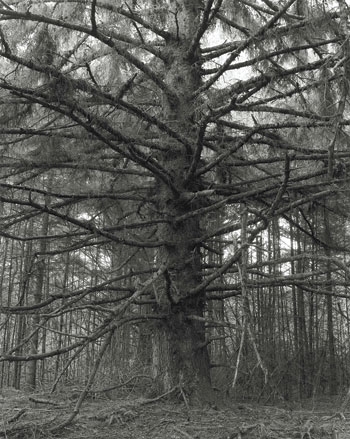Robert Adams: Turning Back, A Photographic Journal of Re-exploration
–
For immediate release: 12/21/06
For further information contact: Douglas Perkins, Administrative Operations Manager, (802) 443–5235
Middlebury, VT—On Thurs., Jan. 25 the Middlebury College Museum of Art will open an important exhibition of contemporary photographs titled “Robert Adams: Turning Back, A Photographic Journal of Re-exploration.” Comprising a suite of 164 photographs, the complete “Turning Back” portfolio recently entered the museum’s collection through the generosity of an anonymous donor. The suite contrasts the present landscape of the Pacific Northwest with what Meriwether Lewis and William Clark first encountered on their legendary 1804 through 1806 exploration of the territories. The exhibit, which includes the entire portfolio, will remain on view at the College Museum through June 3.
Robert Adams is widely recognized as one of the most exacting landscape photographers of our time. Known almost exclusively for his black and white images of the American West, he has spent the last forty years exploring and chronicling the man-made alteration of the American landscape, most notably in Colorado and Oregon. A writer as well as a photographer, Adams is also a passionate and committed environmentalist. His work has garnered him two National Endowment for the Arts Fellowships, two Guggenheim Fellowships, and a MacArthur Foundation Award. He was a major participant in the 1975 International Center for Photography (George Eastman House, Rochester, New York) exhibition “The New Topographics: Photographs of a Man-Altered Landscape.”
Though it has come to fruition in this recent portfolio, the “Turning Back” project began in the 1980s, when the photographer witnessed his late father confront the city council in Astoria, Oregon, in an attempt to stop a plan to clear-cut the nearby forests. Despite ongoing protests at that time, the local government proceeded to remove the trees.
Adams took the Bicentennial of the Lewis and Clark expedition in 2004 as an opportunity to revisit the Oregon landscape that the explorers had described as a vast forest of ancient evergreens. Sent by President Jefferson to explore the Louisiana Territory purchased from the French in 1803, Lewis and Clark mapped the land, assessing its natural resources and forming diplomatic connections with its indigenous peoples. On their journey westward they also discovered new species of trees and collected numerous specimens. But on their return east they experienced violent encounters with some of the native tribes and, in Adams’s words, began to “foul up.” It was then that they murdered some of the indigenous peoples; Lewis himself died on the return, an apparent suicide.
“We need to do better than they did on the return trip,” says Adams, who started the project of Turning Back at the Pacific Coast and roughly retraced the explorers’ journey eastward. In so doing Adams draws a compelling parallel between the explorers’ adversity and what he views as our own current predicament. The photos in the suite serve as observances of what little remains of the majestic landscape Lewis and Clark first encountered.
Ranging in mood from disheartening and funereal to guardedly optimistic, the photographs in the suite tend to regard trees as representatives of the human presence. Some tree stumps are presented like soldiers cut down in the line of fire; other remnants of felled trees are shown bulldozed, like bodies dumped into a mass grave. Still others elicit a cautious celebration of nature’s persistence. “Clear-cutting is going to lead to permanent deforestation, I believe,” says Adams, “so I didn’t want to include in the pictures of clear-cutting anything that might suggest a metaphor for regeneration—beautiful clouds or flowers or whatever. I don’t believe that eventually there will be regeneration. What I wanted to record was an unforgivable crime.” Indeed, Adams has gone to great lengths to craft the composition and effect of these photographs. “So much effort has had to go into trying not to do certain things. Not to use the sky…to rescue the land. Not to be seduced into celebrating the power of men and machines, which can have a Satanic beauty and heroism about it. And not to aestheticize the carnage.”

Robert Adams, Sitka Spruce, Cape Blanco State Park, from theTurning Back portfolio, 1999–2003. Copyright Robert Adams. Courtesy Matthew Marks Gallery, New York and Fraenkel Gallery, San Francisco.
Still, he says, “When I’m photographing in clear-cuts, I know that what has brought me there is a sense of the world coming apart. But after I’ve been there long enough to get over my shock at the violence, after I’ve been working an hour or two and am absorbed in the structure of things as they appear in the finder, I’m not thinking only about the disaster. I’m discovering things in sunlight. You can stand in the most hopeless place and if it’s in daylight you can experience moments that are right, that are whole.”
The exhibition and its accompanying programs are supported at Middlebury by the Christian A. Johnson Memorial Fund, the Program in Environmental Studies, and an anonymous gift. The Turning Back monograph is available for purchase at the Middlebury College Museum of Art bookstore.
The Middlebury College Museum of Art is free and open to the public Tuesday through Friday from 10 a.m. to 5 p.m., and Saturday and Sunday from noon to 5 p.m. It is closed Mondays. The Museum is accessible to people with varying disabilities. Parking is available in the Center for the Arts parking lot. For further information, please call (802) 443–5007 or TTY (802) 443–3155, or visit the Museum’s website at museum.middlebury.edu.
